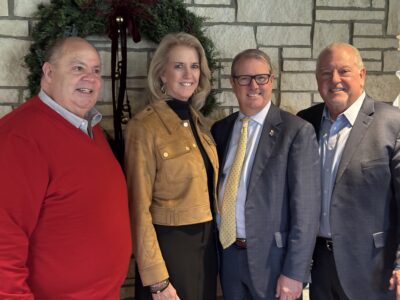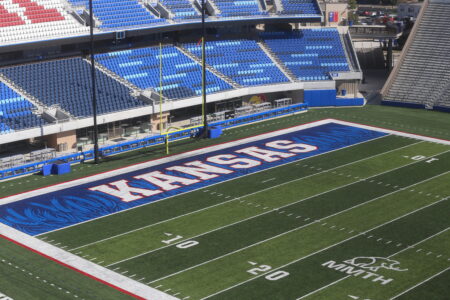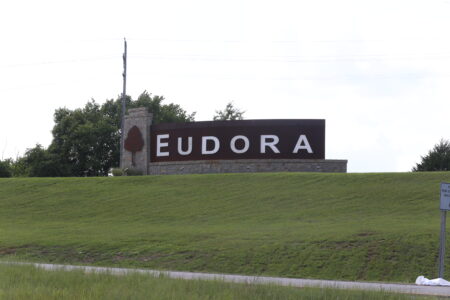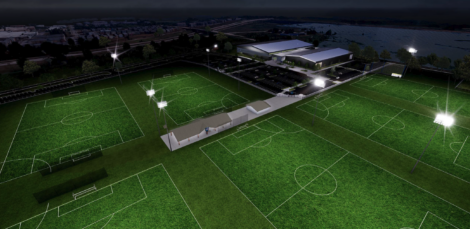
Project to expand South Lawrence Trafficway to four lanes officially underway; work expected through 2028, but perhaps longer

photo by: Chad Lawhorn/Journal-World
The South Lawrence Trafficway is shown in the background on Oct. 2, 2024.
Her position as chair of the Douglas County Commission is what got Karen Willey a seat on the stage Wednesday for a groundbreaking ceremony to expand the western leg of the South Lawrence Trafficway to four lanes.
But a piece of county business isn’t what first popped to mind for Willey when she thought of the approximately $170 million roadway project. Instead, the first thing she told the crowd assembled at the LMH Health West Campus — which is along the SLT at the Sixth Street interchange — is about her 12 years as a volunteer firefighter and the numerous motor vehicle accidents she has responded to.
“I know firsthand the value of a safe road,” Willey said. “Upgrading the K-10 bypass to a four-lane divided highway undoubtedly will save lives.”
On that, many Douglas County residents are likely to agree. The western leg of the SLT bypass is often described as one of the most nerve-wracking roads in the community. The eastern leg of the bypass is a pretty standard four-lane highway with a grass median separating head-on traffic. But when you get to Iowa Street, the bypass suddenly turns into a two-lane highway, where oncoming traffic is only separated by a thin, yellow line.
As we’ve reported multiple times, that is in the process of changing. The Kansas Department of Transportation this summer awarded a $170 million bid to Missouri-based Emery Sapp & Sons to expand the SLT to a four-lane road with a median. A big part of the project also is to eliminate the at-grade crossing at Wakarusa Drive — near the YSI sports complex — and replace it with a true interchange that will eliminate the need for Wakarusa Drive and SLT traffic to mingle. A new bridge will take the SLT over the top of Wakarusa Drive. No more traffic signal will be needed.

photo by: Chad Lawhorn/Journal-World
Hard hats, shovels and simulated dirt awaited local leaders who participated in groundbreaking ceremony for the expansion of the South Lawrence Trafficway on Oct. 2, 2024. The ceremony took place on the rooftop terrace of the LMH Health West campus, which is alongside the trafficway.
So, indeed, Douglas County residents likely don’t have many questions about whether the project will make the road safer. Their top question might be: How long is it going to take, and close behind, how big of a pain will construction be?
KDOT officials provided a few answers at Wednesday’s groundbreaking, which served as the ceremonial start of construction.
As we reported in May, KDOT has said construction will last into 2028 for the project. That timeline has changed a bit for the project. The SLT expansion project is large enough that KDOT decided early on to break it into two parts. The part that is under construction now involves the road-widening, the new Wakarusa interchange, and modifications to the Clinton Parkway and Iowa Street interchanges.
KDOT still expects to have that project done by late 2028.
Not included in the current project, however, is the interchange that connects the SLT with the Kansas Turnpike northwest of Lawrence at the point commonly known as the Lecompton interchange. Major changes are needed to make the SLT flow freely into the turnpike, now that the turnpike now longer operates with toll booths.
KDOT had planned to take bids for that project in late 2025, with construction work beginning in 2026 and lasting through 2028. KDOT officials are no longer committing to that timeline. Instead, they said the timeline for the Lecompton interchange part of the project is undetermined currently. KDOT District Engineer Leroy Koehn told me more time to discuss the project with the Kansas Turnpike Authority might be needed, and other logistical and funding issues still remain to be worked out. However, KDOT doesn’t have any plans to deviate from the proposed design of the Lecompton interchange, which already has been presented to the public.
So, in sum, most of the project should be completed by late 2028, but the final portion on the northern end of the bypass might not be done by then.
As for how disruptive the project will be for motorists who use the SLT, transportation officials are still saying that the road will have two lanes of traffic open at all times. That means motorists should not have to stop and wait for a pilot car or other such disruptions.
Some motorists, however, may recall there were such disruptions recently on the roadway. That indeed was part of the SLT expansion project, as crews are installing barrier walls to protect equipment that will be relocating utility lines and other such work this fall.
But KDOT Metro Engineer Steve Baalman told me those disruptions were a “one-off” situation, and other instances of traffic being stopped on the road for construction should be very rare.
“They will be minor,” Baalman said of disruptions, “because we always remain two-through lanes through everything at all times.”
That said, the construction work will be very noticeable, especially after the winter season, when crews will start in earnest the construction of the new lanes. Work will be happening alongside the existing lanes. Traffic may well shift, and some lanes temporarily may use the paved shoulders of the existing roadway. Some reductions in speed limits also could be in place, KDOT officials have previously said.
At Wednesday’s event, though, most of the focus was on the big-picture issues surrounding the massive project, rather than day-to-day details. Other local leaders who spoke at the event included Lawrence Mayor Bart Littlejohn, State Rep. Mike Amyx and KDOT Secretary Calvin Reed.

photo by: Chad Lawhorn/Journal-World
Kansas Department of Transportation Secretary Calvin Reed speaks at a ground breaking ceremony for the expansion of the South Lawrence Trafficway on Oct. 2, 2024.
Reed told the crowd that he and his family live in the Lecompton area and travel along the current SLT frequently. He has a lot of friends who travel the road too, and he said they often share many comments — sometimes bordering on complaints — about how much road work they will have to endure in the coming years.
“But I promise them that it will be worth it,” Reed said. “I promise them we will have a safer road to travel on and we will be able to get to where we need to get to in and around Lawrence more quickly and more dependably.”
The SLT expansion project — which is technically part of Kansas Highway 10 — might just be the beginning of roadwork that K-10 motorists should expect in the coming years.
As we reported in April, KDOT has been studying the need to expand K-10 to six lanes from De Soto to the I-435 gateway interchange in Johnson County. In April, there were predictions that the project could happen in the next five years, as traffic volumes grow and as the new 4,000 job Panasonic battery factory in De Soto reaches capacity.
On Wednesday, Koehn — KDOT’s district engineer — told me that six-lane project is still a strong possibility, but said no timeline has been set for the project, and it is not imminent. It has not yet been designed, nor has funding been committed to it, so any project is still years away.
While Koehn didn’t say it, it is not hard to envision that when the SLT project wraps up in 2028, the K-10 project at De Soto may be ready to ramp up. If so, K-10 commuters might have the joy of experiencing a decade of construction.







